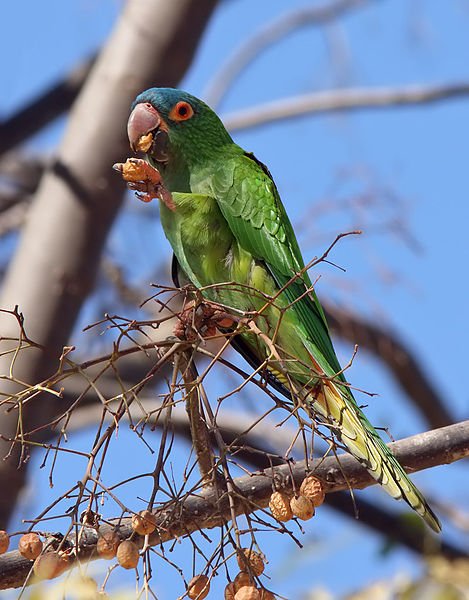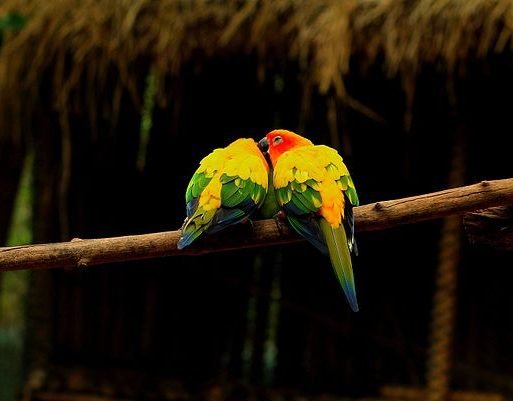Popular after the movie ‘Paulie’, Blue-crowned conures are also famous as Sharp-tailed conures. This colorful parrot with intelligent eyes is native to South America inhabiting regions ranging from the north (Columbia) to the south (Argentina). They have a pointy tail. The length of this bird ranges anywhere between 15 to 17 inches.
Blue-crowned Conure Personality
Blue-crowned conures prefer a company. The owner is expected to spend a lot of time with his bird. These energetic playful parrots are not to be left alone in the cage for playing by themselves. They are considered as a parrot highly social and intellectual. Blue-crowned Conure loves to interact and can be easily trained in vocalization. When one wants to adopt this parrot, he must be sure of spending at least 3 to 4 hours with the bird, all for the bird’s good mental health.
Blue-crowned Conure Lifespan
Blue-crowned Conure is expected to live a life of around 25 years. But the lifespan of a Blue-crowned Conure generally lives anywhere between 25 to 35 years. In the wild, this conure is easily preyed by other wild animals due to their loud nature. In captivity, good care and a healthy diet enhance their lifespan for up to 40 years.
These birds are not to be left locked in a cage. When taken care of in the right way, they can live a happy life of up to 40 years. For a long life expectancy, the strong bond is to be maintained between the pet and the owner. These are not short-term pets. These lovely parrots can live longer than average.
Blue-crowned Conure Colors
These parrots are named Blue-crowned Conure due to their turquoise blue crown and face. The blue color starts from the bird’s forehead coloring the crown, cheeks, and ears. Sometimes, this blue color can be found sprinkled on his breasts too. Though this conure is not as bright as his other cousin conures, this doesn’t mean that he is less colorful.

When born, Blue-crowned conures have reddish tinge on their head which later changes to blue as they grow. The body is dark green with reddish tips on tail feathers. A lighter shade of the deep green colors can be found on his chest and belly, and the head and wings are dark green. The legs and feet are pink which makes the bird more vivid. Eyes of this colorful parrot are surrounded with a white fleshy ring.
The beak has two colors; with upper and lower mandibles each claiming its uniqueness. The upper mandible tends to be horn-colored and the lower, black.
All the colors of this parrot are soft and hold a simple grace. The beauty of Blue-crowned Conure is enhanced due to the blue crown and the varied color shades. The gender difference between male and female Blue-crowned is hardly noticeable. The little difference can be seen in male conure’s eyepatches, which tend to be larger and whiter than the female one.
Blue-crowned Conure Breeding
Blue-crowned Conure breed in tree cavities in their native habitat. In captivity, these birds can be found breeding consistently. These birds can be easily bred. Blue-crowned Conure accepts the nests and is reckoned as prolific breeders. However, they are less prolific than Sun Conure.
As per the norm, two clutches are produced in a season. However, they can produce up to three clutches in a year. The female blue-crowned conure lays three to eight eggs that incubate in the next 26 days. The baby Blue-crowned Conure leaves the nest in about 58 days.
Though Blue-crowned Conures are not dimorphic, it becomes important to manage sexing for determining their sex before breeding. For the experienced breeders, pelvic bone, eye coloring, or feather coloring can help distinguish the bird’s gender. Besides, tests like surgical sexing, DNA, endoscopy, or chromosomal analysis can be undertaken for accurate results.
Blue-crowned Conure Breeding Environment
The Blue-crowned Conure needs a 14″×28″ nest box placed high in the cage. The entry point is recommended through the bottom of the nest box. The box must be ⅔ filled with soft materials such as peat or pine shavings. The ideal humidity level lies between 50 – 55%. They are mature enough for breeding at the age of 2 to 3 years.
Blue-crowned Conure Talking Ability
Blue-crowned isn’t as good as talkers of the parrot kingdom like Quakers, or African Greys. But when it comes to talking abilities, these Conures are famed as good talkers among all the conures. They have a strong vocabulary with high intelligence. They are able to learn several words and phrases. Blue-crowned Conure is easy to teach the vocabulary and once taught, they are one of the best talkers. Blue-crowned Conures are always eager to learn different vocalizations.
They are highly talkative and social and make a very good mate in a family setup. They are ideal mates for kids as well. These playful conures can also be found mumbling quietly to themselves in an attempt to mimic human speech. For all blue-crowned lovers, they are the cutest when they talk.
Are Blue-crowned Conures Noisy?
Blue-crowned Conures are undoubtedly noisy. One must be sure that he doesn’t mind all the raucous calls made by a Blue-crowned Conure. They can be very loud and vocal.
The alarm calls of these conures are mostly a few minutes in the morning and evening. And it also happens to be that time of the day when they can seem noisiest. The noisy behavior can create problems for the people in the neighborhood.
Blue-crowned Conure Gender Difference
Blue-crowned Conures are monomorphic. They are hard to identify when it comes to their gender. Both sexes have almost identical bodies. An experienced breeder can tell the differences between male and female conures, albeit with a keen eye. The male conure has a larger white eyepatch than their female counterparts. But it is always good to be 100% accurate. Additionally, before practicing breeding, DNA sexing is mandatory. The breeding must be performed only after DNA sexing.
DNA sexing is recommended via feather sampling. The process is as follows:
- Pluck about four to six feathers from Blue-crowned Conure’s breast area.
Place them in an envelope provided by the testing company.
Ask a professional bird veterinarian to test the sample. - For DNA sexing via a blood sample, the following procedure must be adopted:
- A blood DNA test card is to be obtained from the testing agency.
– The sample must be collected by clipping the bird’s toenail.
– Two to three drops of blood must be dabbed on the test card.
Pro Tip:
Feathers should only be plucked from the breast area.
The blood clotting medications must be kept handy at the time of getting the sample.
Samples must be taken either from blood or feathers.
Blue-crowned Conure Diet
In their native habitat, Blue-crowned Conure lives on a varied diet. Their diet in the wild includes fresh fruits, vegetables, berries, nuts, and grains.
Blue-crowned needs an equally varied diet in captivity. Conures need fresh food in the mornings. They are highly hungry at that time. The diet of conures in captivity must have an addition of premium quality pellets. The pellets must be around 60-70% of his diet. Conures eat green vegetables, fresh fruits, nuts, and berries in captivity as well. The uneaten food must be removed from their cage after the feeding period.
Generally, half a cup of pellets is offered to a Blue-crowned conure for the very first time. Consumption capability is observed then. If the bird eats all the offered pellets, more can be offered. Blue-crowned Conure’s body weight is 20% made of what they eat. The fatty conures who only eat nuts and seeds tend to have more health concerns.
Meals can be offered twice a day. The diet of a particular Blue-crowned Conure can not be determined in amount. One must notice how much his/her conure can eat in a day. And follow the diet accordingly. But one must remember not to go overboard with the quantity to prevent the bird from getting obese. And even if the bird seems to eat a bit more fat in the form of seeds or nuts, offer him plenty of fresh water. It flushes out water-soluble fat from the body along with keeping the bird hydrated.
Blue-crowned always have a busy beak. They love to chew. Chewing also helps in trimming his beak. The best option is to add a cuttlebone to his cage to trim his beak by simultaneous addition of calcium in his body reserves.
Pro Tip: Chocolates, caffeine, and avocado are toxic to Blue-crowned Conures and must not be served for their good.
Summing Up
Blue-crowned Conures form a very affectionate and friendly pet. They don’t talk too much. They are quiet and calm. An untrained blue-crowned can be loud at times but a well-trained one knows how to behave. This parrot can bite their human at times out of anger or hurt but they are one of the sweetest. These conures are indeed loyal to their human flock. The multitudinous qualities make a Blue-crowned Conure a good pet. They are costly for a good reason.
Featured Photo Credit: Håkan Sandin / CC BY-SA (https://creativecommons.org/licenses/by-sa/2.0)




